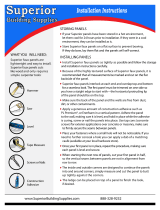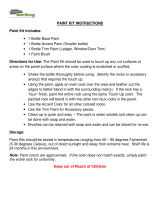Page is loading ...

Painting Tips & Techniques
Purdy® has spent many years with both professional painters and serious DIY painters,
observing them and answering many questions. We have compiled the following painting
tips and techniques to help meet your needs. However, please feel free to contact us
directly with your individual question.
Which paint brush do I use for various types of paints?
A natural bristle paint brush is made from animal hair, and is very soft and porous. For oil-
based paints, most professionals choose a natural China-bristle (hog hair) paint brush.
If you are painting a smooth surface with oil-based paint, a natural White Bristle paint brush
is your best choice because it is soft and supple. When painting a textured surface, a
natural Black Bristle paint brush will work better, because it is stiffer and has superior abrasion
wear. When you require an ultra-fine finish, a brush blended with ox hair is the best choice.
Synthetic filament - When your choice in coatings is water-based (frequently referred to as
latex), it is absolutely essential that you select a synthetic filament paint brush. The Purdy
synthetic filament range includes:
100% black nylon
100% dyed nylon
Nylon/polyester blend
100% Chinex® filament
Chinex/nylon blend
Chinex/polyester blend
Chinex/nylon/polyester blend
Brushes that include a blend of polyester, such as our XL™ Elite™ series and PRO-EXTRA®
series maintain their bend and recovery (or flex) better than brushes made of 100 percent
nylon. This characteristic enables an XL Elite or PRO-EXTRA professional paint brush to
perform consistently well in warm, humid weather conditions.
When painting exclusively indoors under controlled climatic conditions, a 100 percent nylon
paint brush is a great choice, because stiffness retention is not as critical a factor.

Furthermore, 100 percent nylon filament allows the paint to release from the brush easier
and flow more smoothly onto the working surface.
It is worth mentioning that Purdy synthetic filament paint brushes also perform exceedingly
well in oil-based paints. This is due to the various processing and finishing steps in our
manufacturing operation that soften the synthetic material and eliminate drag when used
with oil-based paints.
To select a specific brush or roller for your application, visit our Painting Tool Selector.
Which paint roller is the best choice for various types of paints?
Most people believe that all paint rollers look and feel similar, but it's important to keep the
following painting tips in mind to achieve professional painting results:
Woven roller cover - Paint rollers that are made of woven material, such as the
Purdy White Dove™ roller cover, are virtually shed-free because they are made
out of continuous yarn. Every thread that makes up the face fabric is locked to
the back of the fabric. These roller covers are recommended for smooth surfaces
such as doors, paneling and smooth walls.
Knitted roller cover - Paint rollers that are made out of knitted material are usually
used for rough or semi-rough surfaces, such as rough-cut siding, stucco or
textured walls and ceilings. We recommend the Purdy Golden Eagle™ paint
roller. This roller cover contains a high-density material that will hold a lot of paint
without dripping.
Selecting the pile (or nap) - The more texture desired, the higher the pile should
be. A 1/2-inch plus pile height is ideal for a stippled effect common to most
homes. Pile heights on some Purdy textured paint roller covers are as high as 1-
1/4 inches, creating an extremely textured effect. Conversely, if you desire a
smooth finish in your kitchen, bath or utility room, use low-pile 1/4-inch to 3/8-inch
roller covers such as the White Dove and Parrot™ paint roller covers.
Painting tips for cutting in with Purdy brushes.
"Cutting in" is the art of drawing a straight line, separating two colors using only the paint
brush - no masking tape or other aid. You often see it at the edge where a wall color is cut
into a different ceiling color. When cutting in, follow these simple rules:
Use a fully loaded brush.
Using the brush parallel to the area to be cut, let the paint brush open up into a
semi-oval and bring it into the line you are cutting. Follow the line until the line of
paint begins to break up. Repeat. It is best to cut in while breathing out or
holding your breath.
Work into the previous area.
When can I apply the next coat of paint?
Generally, a second coat of paint should be applied at least two hours following
application of the previous coat. However, if it is humid or you are using a heavily tinted
paint, it can take longer.

How do I create special effects with my painting (faux finishing)?
Since 1949, Symphony by Purdy has established itself as a leading manufacturer of special
effect tools. Faux finishing painting techniques are used to create unique finishes including
stippling, stenciling, sponging, dragging, color washing, veining, softening and spattering.
If you have questions about desired faux finishes, painting techniques or faux finishing tools,
please contact us.
When can I clean my painted walls?
Normally, wait at least two weeks before cleaning to give the paint time to cure. Some
manufacturers require 30 days, so be sure to read the directions on the paint you are using.
What's the best way to touch up paint?
To achieve acceptable touch-up results, it's important to apply touch-up paint using the
same painting technique as the original application, if possible, to avoid having any
difference in sheen or texture. Be sure to use paint from the original batch and under similar
temperature and humidity conditions, as well.
Repair the defects first. Then scuff sand the area around the patched area and apply a
drywall primer.
For painting, apply a thin coat, reducing some of the original paint by about 25 percent.
Then apply the paint to the center of the patched area, using the original application
method, and work it away from the patch.
By feathering the touch-up out from the patch, the difference in film build and appearance
should be minimal, since you will be blending it into the surrounding areas. If the repaired
areas are still noticeable, you may have to paint the entire wall.
/




